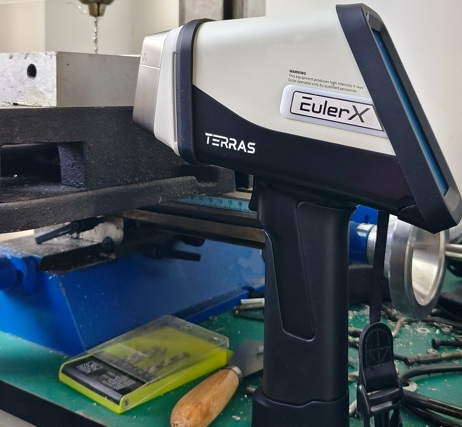
soil
A high-tech enterprise focusing on the development and application of X-ray technology products, committed to becoming a leading supplier of X-ray industrial testing solutions.
Understanding Lead Contamination in Soil: Causes, Risks, and Solutions—XRF technology
Lead contamination in soil is a serious environmental concern, particularly in urban areas, near industrial sites, or in regions with a history of lead-based products such as paint, gasoline, and batteries. Lead is a toxic heavy metal that can pose significant health risks, particularly to children, pregnant women, and pets. One of the most effective ways to identify and assess lead contamination in soil is through X-ray fluorescence (XRF) technology. In this blog post, we’ll explore the causes of lead contamination in soil, the risks it poses, and how XRF technology can help detect and manage this issue.

Terras EulerX900 Handheld Alloy Analyzer
What Is Lead Contamination in Soil?
Lead contamination in soil occurs when lead, a harmful heavy metal, accumulates in the ground due to various human activities or natural processes. While small amounts of lead are naturally present in the earth’s crust, excessive concentrations are typically the result of industrial activities, historical use of lead-based products, or improper waste disposal.
Health Risks for Humans:
Children: Lead exposure is especially dangerous for children. It can affect brain development, leading to cognitive deficits, developmental delays, and learning disabilities. Even small amounts of lead exposure in children can cause long-term health issues.
Pregnant Women: Lead exposure during pregnancy can cause premature birth, low birth weight, and developmental problems in the fetus. Lead can cross the placenta and affect the developing baby’s nervous system.
Adults: For adults, chronic exposure to lead can result in kidney damage, high blood pressure, and reproductive issues. Long-term lead exposure has also been linked to cardiovascular disease and neurological disorders.
How XRF Technology Works in Soil Testing
XRF is an advanced analytical method that uses X-rays to determine the elemental composition of a material. In soil testing, an XRF analyzer is placed on the surface of the soil sample. When the XRF device emits high-energy X-rays, the elements in the soil become excited and emit their own secondary (or fluorescent) X-rays. These emitted X-rays are characteristic of the elements present in the soil and can be analyzed to identify and quantify the concentration of lead and other contaminants.
Benefits of XRF for Soil Lead Detection:
Rapid Results: XRF provides immediate results, allowing for quick decision-making. Traditional lab tests can take several days, while XRF testing can deliver data in just a few minutes.
Non-Destructive Testing: XRF testing does not require soil samples to be destroyed or chemically altered. The soil sample remains intact, making it ideal for fieldwork where minimal disturbance is necessary.
Portable and Convenient: XRF analyzers are portable and can be used in the field, reducing the need to send samples to distant laboratories. This makes the process more efficient and cost-effective for environmental consultants, site managers, and homeowners.
Multi-Element Analysis: In addition to lead, XRF can detect a wide range of heavy metals, including arsenic, cadmium, mercury, and chromium. This allows for comprehensive soil testing that can identify multiple contaminants at once.
Accurate and Reliable: XRF technology provides highly accurate measurements with a high degree of precision. This helps ensure that contamination levels are accurately assessed for risk management and regulatory compliance.
Solutions for Managing Lead Contamination in Soil
Once lead contamination is detected, the next step is to take action to reduce or eliminate the risk. The solution depends on the severity of the contamination, the intended use of the land, and the resources available. Common approaches to managing lead-contaminated soil include:
Soil Removal and Replacement: In cases of high contamination, excavating and replacing the contaminated soil may be the most effective solution. This is typically done in small areas, such as residential gardens or playgrounds, where children are at higher risk.
Soil Capping: For less severe contamination, soil capping involves placing a layer of clean soil or other materials over the contaminated soil. This prevents direct contact with the lead-contaminated soil and can be used in areas such as parks, public spaces, or gardens.
Phytoremediation: This is an eco-friendly method in which plants that can absorb lead from the soil are used to gradually remove the contamination. The plants are then harvested and disposed of safely.
Soil Amendments: Adding certain materials like organic matter, lime, or phosphate to the soil can reduce lead bioavailability, making it less likely to be absorbed by plants or animals. This can help reduce the potential for lead exposure in agricultural settings.
Ongoing Monitoring: Regular soil testing is necessary to monitor contamination levels and ensure that remediation efforts are effective. XRF technology is particularly useful for ongoing monitoring, as it allows for efficient testing without the need for extensive lab analysis.
The EulerX 900 series has proved to be an excellent choice for metal analysis in a wide fields, providing fast, accurate results directly to the user. Thanks to its cutting-edge electronics and sophisticated mathematical algorithms, the EulerX 900 series ensures superior measurement quality within seconds. This makes it an ideal tool for inspecting and analyzing incoming materials, finished products, and in-process production parts in a non-destructive manner. Its simplicity of operation allows users to quickly view alloy grade and chemical composition on the touch screen display, achieving laboratory-quality analysis with minimal training and virtually no need for sample preparation, regardless of the sample is shape or size.

Terras EulerX900 Handheld Alloy Analyzer
Conclusion: The Importance of XRF in Addressing Lead Contamination
XRF technology offers a fast, non-destructive, and accurate way to detect lead and other heavy metals in soil, making it an invaluable tool for environmental testing and remediation. With the help of XRF, we can identify contaminated sites, assess risks, and implement solutions to mitigate the dangers of lead exposure. As awareness of soil contamination grows, XRF technology will continue to play a crucial role in safeguarding communities and ecosystems from the harmful effects of lead.
Join Us
Subscribe to our email list for updates & promotions.



